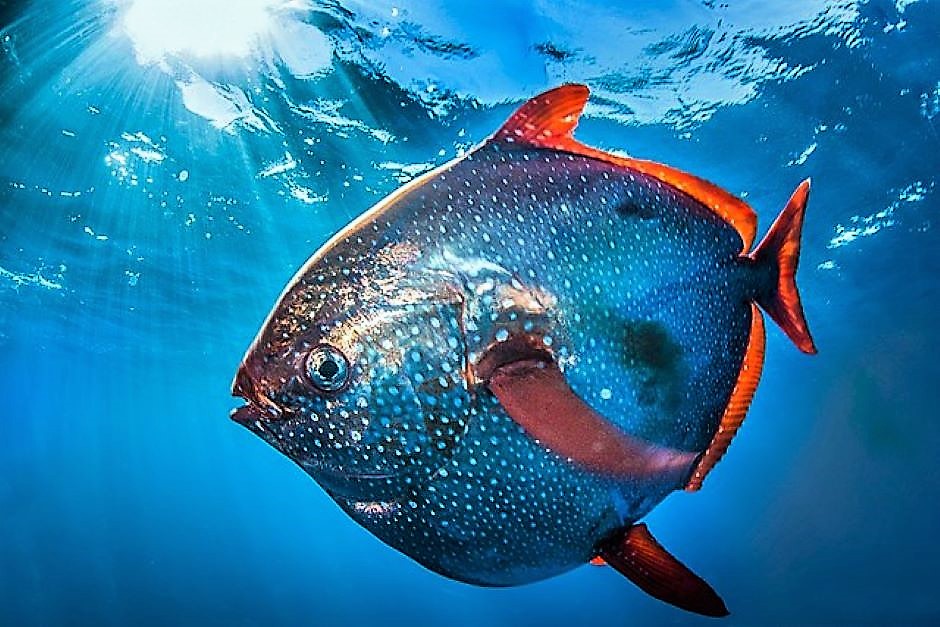Opah: The First Warm-Blooded Fish
 Lampris guttatus (Credit: Ralph Pace/NOAA Fisheries, via Public Domain)
Lampris guttatus (Credit: Ralph Pace/NOAA Fisheries, via Public Domain)Research from the National Oceanic and Atmospheric Administration’s Fisheries division uncovered the first fully warm-blooded fish in 2015. The opah, also known as the moonfish, circulates heated blood throughout its entire body, giving it an edge over its cold-blooded prey in the cooler depths of the ocean.
Scientists know that some fish, such as tuna and certain sharks, exhibit regional endothermy, in which the temperature of isolated organs or muscles is regulated by blood flow. According to a paper published in the journal Science, the opah is a true endotherm—much like a mammal or bird–and heats its body through a system of blood vessels in its gills.
How the Opah was Discovered
“It was kind of an opportunistic study, said Nick Wegner, a research fisheries biologist at NOAA and lead author of the paper. “We weren’t out looking for the first fully warm-blooded fish; we actually stumbled upon it.”
Wegner was working on an NOAA Fisheries shark survey when he made the discovery. With hundreds of hooks trawling behind the research vessel on miles of line, Wegner says it’s no surprise that sharks aren’t the only creatures hoisted onto the deck during these cruises. One fish, however, has been making more frequent appearances.
“The last few years, for reasons we still don’t understand, we’ve been catching opah, which has served as a good opportunity to study this fish,” Wegner said.
While examining a sample of opah gill tissue, Wegner came across an unusual blood vessel arrangement that resembled a car radiator in design. Vessels carrying warm blood into the opah’s gills wrapped around those carrying blood back into the body, warming the cooler blood as it travels from the respiratory surface in a process called counter-current heat exchange.
Warming Up Beforehand
The blood vessel design essentially isolates the gills’ respiratory surface — an area of significant heat loss — from the rest of the body. A warm body improves muscular and cardiovascular performance and allows the opah to spend more time in deeper parts of the ocean to catch prey. Regional endotherms can outperform prey in deep water as well, but only until their hearts inevitably cool, forcing them to return to the surface.
“Being warm will increase their swimming speed, increase their reaction times,” Wegner said. “This gives them a real advantage over their prey, which are going to be much colder.”
Understanding the Circulation of Opah
Wegner and a team of researchers tested the opah’s self-warming capabilities in the field, capturing individuals and inserting thermocouples into their muscles. The moonfish were then released with the thermocouples attached to a buoy-mounted data logger, permitting the researchers to monitor the fish’s performance and at-depth temperatures as they swam around a limited range. Some of the fish were tagged before being released back into the ocean.
Unhealthy opah specimens were set aside for dissection. Wegner injected their blood vessels with vascular casting solutions, with vessels moving towards the gills dyed blue, and those leaving the gills dyed red, representing anoxic and oxygenated blood, respectively. This method of “highlighting” the blood vessels offered an intimate glimpse into the workings of the opah’s vascular system.
The study’s findings came as a surprise to NOAA Fisheries and the scientific community. However, Wegner says there’s still plenty more to learn about the opah, both concerning its endothermy and the increase in incidental catches over the last five years.
“We’re going to continue studying them; there’s a lot left to look at,” Wegner said. “We’ll start looking at a lot of different aspects of the blood and muscle tissue — how does this work with the rest of its biology?”
Questioning the Global Increase in Appearances
Part of the reason that opah have yet to be assessed closely is because the fish are typically caught incidentally and aren’t targeted by anglers. Up until recently, the moonfish was a rare sighting for fishermen attempting to capture other deep-water fish. The fish may not be commercially sought after, but the opah is still popular with recreational anglers due to its unique colors and mild flavor.
According to the NOAA, opah are often caught in gillnets by anglers targeting swordfish. Similarly, Hawaiian fishers will often catch moonfish in longlines originally set deep below to catch bigeye tuna.
The NOAA has helped sponsor tagging programs like that of the Southwest Fisheries Science Center, which was started in 2011, before even knowing of their warm-blooded system. The program was started in hopes of increasing understanding of swimming patterns, how deep opah swim and how often they come near the surface. The data can also be used to conduct population assessments and curate appropriate management strategies.



Pingback: FishSens Magazine | Climate Change Altering Fish Distributions - FishSens Magazine